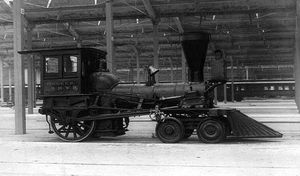4-2-0
2007 Schools Wikipedia Selection. Related subjects: Railway transport

In the Whyte notation, a 4-2-0 is a railroad steam locomotive that consists of a 4-wheel leading truck followed by a single driving axle. This type of locomotive, often called a Jervis type, was common on American railroads from the 1830s through the 1850s.
The equivalent UIC classification is 2'A.
History
The first 4-2-0 built was the Experiment (later named Brother Jonathan) for the Mohawk and Hudson Railroad in 1832. It was built by the West Point Foundry based on a design by John B. Jervis. Having little else to reference, the manufacturers patterned the boiler and valve gears after locomotives built by Robert Stephenson of England.
This had developed from the 2-2-2 design of his first Long Boiler locomotive, which he had altered to place two pairs wheels at the front with the outside cylinders between them to improve stability.
A few examples of Stephenson locomotives were already in operation in America, so engineers did not have to travel too far to get their initial ideas.
The design is a modification of the 0-4-0 design then common in America. The 0-4-0 proved to be too rigid for the railroads of the day, often derailing on the tight curves and quick elevation changes of American railroads. For the 4-2-0, Jervis designed a four-wheel leading truck under the locomotive's smoke box that swiveled independently from the main frame of the locomotive. The pistons powered a single driving axle at the rear of the locomotive, just behind the firebox. This design resulted in a much more stable locomotive that was able to guide itself into curves more easily than the 0-4-0.
This design proved so effective on American railroads that many of the early 0-4-0s were rebuilt as 4-2-0s. The 4-2-0 excelled in its ability to stay on the track. But with only one driving axle, the locomotive's weight was spread over a small proportion of the powered wheels, which meant its total power was substantially reduced.
One possible solution, patented in 1835 by Charles and George E. Sellers, caused the locomotive to tip upward while it was ascending a grade. This plan placed more of the locomotive's weight on the driving axle, but by reducing the weight on the leading truck, also made it more prone to derailments.
A more practical solution, first put into production by Norris, moved the driving axle to a location on the frame in front of the locomotive's firebox. Cantilevering the weight of the firebox and the locomotive crew behind the driving axle placed more weight on the driving axle without substantially reducing the weight on the leading truck. However, Norris's design led to a shorter wheelbase, which tended to offset any gains in the tractive force on the driving axle by reducing the locomotive's overall stability.
As the 1840s approached, and more American railroads were experimenting with the new 4-4-0 locomotive type, the 4-2-0 fell out of favour as it was not as able to pull a paying load on the railroad as the 4-4-0.
4-2-0s were built into the 1850s, but their use was restricted to light-duty trains as most railroads by this time had found them unsuitable for regular work.